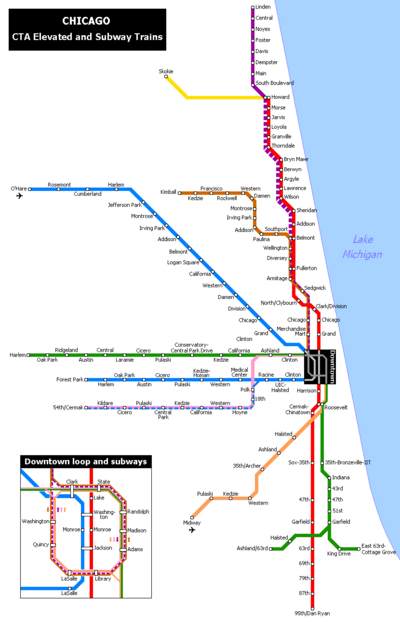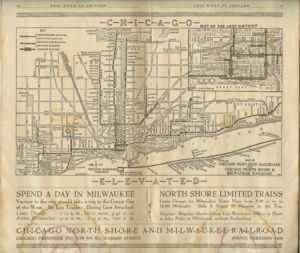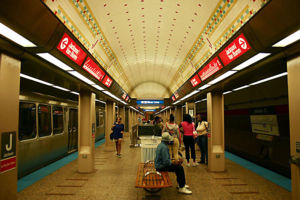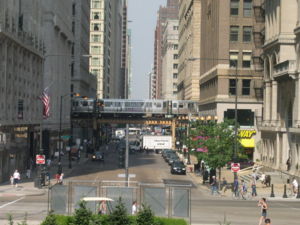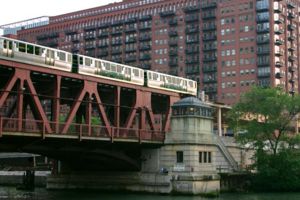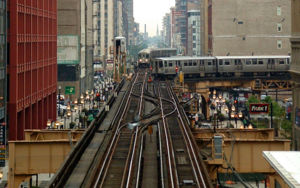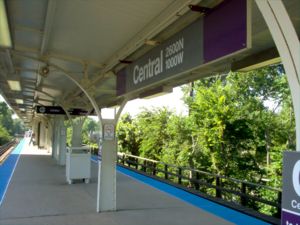Chicago 'L'
| 150px | |
| Locale | Chicago, Illinois |
|---|---|
| Transit type | Rapid transit |
| Began operation | 1892 |
| System length | 106.1 mi (170.6 km) |
| No. of lines | 8 |
| No. of stations | 144 |
| Daily ridership | 658,524 (avg. weekday, 2006) |
| Track gauge | 1,435 mm (4 ft 8½ in) (standard gauge) |
| Operator | Chicago Transit Authority (CTA) |
The 'L'[1], variously, if perhaps incorrectly, styled "L," El, EL, or L, is the rapid transit system that serves Chicago, Illinois in the United States. It is operated by the Chicago Transit Authority (CTA), which also runs the city's bus system. It has been credited with helping create the densely built-up downtown that is one of Chicago's distinguishing features.[2]
The 'L' consists of a network of eight heavy rail lines totalling 106.1 route miles (57.1 miles elevated, 36.9 miles surface, and 12.1 miles subway) on over 242.6 miles of double-track rail line with 144 stations. The oldest section dates from 1892. The 'L' primarily serves the city proper plus eight close-in suburbs; service to more distant suburbs is provided by the Metra and South Shore Line (NICTD) commuter rail systems. Seventeen stations, mainly newer or at outlying locations, include "park-'n'-ride" facilities with a total of more than 6,600 parking spaces. About 15% of the total track length is underground.
The 'L' is the third busiest rail mass transit system in the United States, behind New York City's and Washington, D.C.'s; and by age is the second oldest rapid transit system in the Americas after Boston's. [3] It is one of the few rapid transit systems in North America providing 24-hour service, though only on the two busiest lines.[4] On average 658,524 people ride the 'L' each weekday, 419,258 each Saturday, and 315,240 each Sunday.[5] Annual ridership for 2006 was 195.2 million, the highest since 1993.[6].[7]
Although the 'L' gained its nickname because large parts of the system are elevated,[8] the Red and Blue lines traverse the downtown area in subways, and also have long sections in the medians of expressways that lead into and out of Chicago. Chicago pioneered the use of the expressway median for rail lines in the 1950s. There are also open-cut and/or grade-level portions (with street crossings) on some parts of the system.
Noisy and at times slow and overwhelmingly crowded, the 'L' has nonetheless become one of the symbols of the city it serves. In a 2005 poll, Chicago Tribune readers voted it one of the "seven wonders of Chicago," [9] behind the lakefront and Wrigley Field but ahead of Sears Tower, the Water Tower, the University of Chicago, and the Museum of Science and Industry.
Contents
Lines
- Main article: List of stations on the 'L'
Chicago's rapid transit system currently consists of eight principal routes. Since 1993 'L' lines have been identified by color,[10] although older route names survive to some extent in CTA publications and popular usage to distinguish branches of longer lines:
Red Line
█ Red Line, consisting of the Howard and Dan Ryan branches
- The Red Line is the busiest 'L' route, serving approximately 213,800 passengers each weekday.[11] It includes 34 stations on its 21.8 mile route, traveling from Howard Street terminal on the city's northern border with Evanston, through downtown Chicago via the State Street subway, then down the Dan Ryan Expressway median to 95th Street on the Far South Side. Despite its length, the Red Line stops five miles short of the city's southern border and there are intermittent pleas to extend it. The Red Line is one of two 'L' lines operating 24 hours a day, 7 days a week.
Blue Line
█ Blue Line, consisting of the O'Hare and Congress branches
- The Blue Line extends from O'Hare International Airport through the Loop via the Milwaukee-Dearborn-Congress subway to the West Side. Most Blue Line trains travel to Des Plaines Avenue in Forest Park via the Eisenhower Expressway median, but during rush hour some trains operate between O'Hare and 54/Cermak in Cicero via the Douglas branch. (Most service to 54/Cermak is provided by the Pink Line; see below.) The length of the route is from O'Hare to Desplaines Ave in Forest Park is 26.93 miles and from O'Hare to 54th St. it is 24.23 miles. The combined number of stations is 44. Until 1970 the northern section of the Blue Line terminated at Logan Square, during which time it was called the Milwaukee route after the parallel street; in that year service was extended to Jefferson Park via the Kennedy Expressway median, and in 1984 to O'Hare. The Blue Line is the CTA's second busiest, with 119,700 weekday boardings. It operates 24 hours a day, 7 days a week.
Brown Line
█ Brown Line, or Ravenswood
- The Brown Line follows an 11.4 mile route, with 19 stations between Kimball Avenue in Albany Park and downtown Chicago. The Brown Line has an average weekday ridership of 66,000. [12]
Green Line
█ Green Line, consisting of the Lake Street and Englewood-Jackson Park branches
- A completely elevated route utilizing the system's oldest segments (dating back to 1892), the Green Line extends 20.8 miles with 29 stops between Forest Park and Oak Park (Harlem/Lake), through Chicago's Loop, to the South Side. South of the Garfield station the line branches, with trains alternately heading to Ashland/63rd in Englewood and Cottage Grove/63rd in Woodlawn. The East 63rd branch formerly extended to Jackson Park, but the portion east of Cottage Grove, which ran above 63rd Street, was demolished in stages in the 1980s and 1990s due to structural problems and then not replaced due to community demands. The average number of weekday boardings is 36,300.
Orange Line
█ Orange Line or Midway
- The 13 mile long Orange Line was constructed in the early 1990s on existing railroad embankments and new concrete and steel elevated structure. It runs from Chicago Midway International Airport on the Southwest Side to the Loop in downtown Chicago. Average weekday ridership is 28,400.
Pink Line
- The Pink Line is an 11.2 mile trial rerouting of former Blue Line Douglas Park branch trains from Cicero (54/Cermak) via the previously non-revenue Paulina Connector and the Green Line on Lake Street to the Loop. Its average weekday ridership is 12,600.
Purple Line
█ Purple Line, or Evanston, Evanston Express
- The Purple Line is a 3.9 mile branch serving north suburban Evanston and Wilmette with express service to the Loop during rush hour. The local service operates from the Wilmette terminal at Linden Avenue through Evanston to the Howard Street terminal where it connects with the Red and Yellow lines. The rush hour express service continues from Howard to the Loop, running nonstop on the four-track line used by the Red Line to Belmont station, then serving all Brown Line stops to the Loop. Average weekday ridership is 10,300, although this does not count boardings from Belmont south, which are included in Red and Brown line statistics. The stops from Belmont to Chicago Avenue were added in the 1990s to relieve crowding on the Red and Brown lines.[13]
Yellow Line
█ Yellow Line, or Skokie Swift
- The Yellow Line is a 4.7 mile nonstop shuttle that runs from the Howard Street terminal to Dempster Street terminal in suburban Skokie. The Yellow Line is the only 'L' route that does not provide direct service to the Loop or run on weekends. This line was originally part of the North Shore Electric commuter rail service, and was acquired by the CTA in the 1960's. Its average weekday ridership is 2,600.
Circle Line (Proposed)
The Circle Line is a proposed addition to the CTA rail system that would form an outer circle or loop around the downtown area, making connections easier further outside the original downtown core. Several routes have been proposed, with no selection having been made to date.
Brown, Green, Orange, Pink, and Purple Line express trains serve downtown Chicago via the Loop elevated. The Green Line is the Loop's only through service; the other four lines circle the Loop and return to their starting points. The Loop forms a rectangle roughly 0.4 miles (650m long) east-to-west and 0.6 miles (960m) long north-to-south. While many believe that the city's central business district was named after this conspicuous section of the "L", the term actually predates the "L" and refers to a now-retired circular routing of streetcars through downtown, which followed the same basic route as the present day elevated tracks. The Loop's nine stations average 64,800 weekday boardings.
Mid-City Line (Proposed)
The Mid-City Line is another proposed line that would run along a route similar to the failed Crosstown Expressway, though primarily on existing railroad right of way. The route would link various points in the city from the northwest, west & southwest sides outside of the downtown area & their existing transit lines.
The line would run mostly on existing Union Pacific and Belt Railway right of way and, unlike existing Chicago Transit Authority routes that radiate from the Loop, would connect city neighborhoods on the Northwest, West and South Sides.
Beginning approximately at the location of the Jefferson Park station on the Blue Line, it would head south paralleling Cicero Avenue (the planned corridor for the original Crosstown), past Midway Airport before curving east along 75th Street, eventually terminating at 87th Street and the Dan Ryan Expressway.
Besides the Blue Line, the Mid-City route would intersect with the CTA's Green, Orange and Red Lines.
The Mid-City Line, along with the Circle Line would greatly improve transit in Chicago by linking the different spokes of the present rail lines like a spiders web. Both plans are pending further studies & funding. If Chicago wins the bid for the 2016 Olympics, there is no doubt that one or even both of the plans could finally become reality as Federal funding would more easily secured.
History
The first 'L' began revenue service on June 6, 1892, when a small steam locomotive pulling four wooden coaches with 30 passengers left the 39th Street station of the Chicago & South Side Rapid Transit Railroad and arrived at Congress Street 14 minutes later over tracks still used today by the Green Line.[14] The following year service was extended to 63rd Street and Stony Island Avenue, then the entrance to the popular World's Columbian Exposition in Jackson Park. Later in 1893 trains began running on the Lake Street Elevated and in 1895 on the Metropolitan West Side Elevated, which consisted of the Douglas Park, Garfield Park (since replaced), Humboldt Park (since demolished), and Milwaukee lines – see map. The Metropolitan was the world's first non-exhibition rapid transit system powered by electric traction motors, a technology whose practicality had been previously demonstrated on the "intramural railway" at the world's fair. Two years later the South Side 'L' introduced multiple-unit control, in which several or all the cars in a train are motorized and under the control of the operator, not just the lead unit. Electrification and m.u. control remain standard features of most of the world's rapid transit systems.
A drawback of early 'L' service was that none of the lines entered the central business district. Instead trains dropped passengers at stub terminals on the periphery due to a state law requiring approval by neighboring property owners for tracks built over public streets, something not easily obtained downtown. This obstacle was overcome by the legendary traction magnate Charles Tyson Yerkes, who went on to play a pivotal role in the development of the London Underground and was immortalized by Theodore Dreiser as the ruthless schemer Frank Cowperwood in The Titan (1914) and other novels. Yerkes, who controlled much of the city's streetcar system, obtained the necessary signatures through cash and guile – at one point he secured a franchise to build a mile-long 'L' over Van Buren Street from Wabash Avenue to Halsted Street, extracting the requisite majority from the pliable owners on the western half of the route, then building tracks chiefly over the eastern half, where property owners had opposed him. The Union Loop opened in 1897, greatly increasing the rapid transit system's convenience but at the cost of noisy, obstructed streets, a fact of life in downtown Chicago to this day. Operation on the Yerkes-owned Northwestern Elevated, which built the North Side 'L' lines, began three years later, essentially completing the elevated infrastructure in the urban core although extensions and branches continued to be constructed in outlying areas through the 1920s.
Rarely profitable, the 'L' lines after 1911 came under the control of Samuel Insull, president of the Chicago Edison electric utility (now Commonwealth Edison), whose interest stemmed initially from the fact that the trains were the city's largest consumer of electricity. Insull instituted many improvements, including free transfers and through routing, although he did not formally combine the original firms into the Chicago Rapid Transit Company until 1924. He also bought three other Chicago electrified railroads, the North Shore, Aurora and Elgin, and South Shore interurban lines, and ran the trains of the first two into downtown Chicago via the 'L' tracks. This period of relative prosperity ended when Insull's empire collapsed in 1932, but later in the decade the city with the help of the federal government accumulated sufficient funds to begin construction of two subway lines to supplement and, some hoped, permit eventual replacement of the Loop elevated. The State Street subway was completed in 1943; the Dearborn subway, work on which was suspended during World War II, opened in 1951. The subways bypassed a number of tight curves and circuitous routings on the original elevated lines (Milwaukee trains, for example, originated on Chicago's northwest side but entered the Loop at the southwest corner), speeding service for many riders.
By the 1940s the financial condition of the 'L,' and of Chicago mass transit in general, had become too precarious to permit continued private operation, and the necessary steps were taken to enable public takeover. In 1947 the Chicago Transit Authority acquired the assets of the Chicago Rapid Transit Company and the Chicago Surface Lines, operator of the city's streetcars. Over the next few years the CTA modernized the 'L,' replacing antiquated wooden cars with new steel ones and closing lightly used branch lines and stations, many of which had been spaced only a quarter mile apart. The first air-conditioned cars were introduced in 1964 and the last pre-World War II cars retired in 1973. New lines were built in expressway medians, the Congress branch replacing the Garfield Park 'L' in 1958 and the Dan Ryan branch opening in 1969, followed by the first Kennedy Expressway extension in 1970.
The 'L' today
'L' ridership has increased steadily in recent years after catastrophic losses in the late 1980s and early 1990s. Ridership had been remarkably stable for nearly 40 years after the CTA takeover despite declining mass transit usage nationwide, with an average of 594,000 riders boarding each weekday in 1960[15] and 577,000 in 1985. Thereafter, however, ridership dropped sharply, bottoming out at 418,000 in 1992,[16] when the Loop Flood forced the CTA to suspend operation for several weeks in the State and Dearborn subways, used by the most heavily traveled lines.
Overall traffic volume has since recovered, although growth has not been uniformly distributed, with usage of North Side lines generally up, often dramatically so, while that of West and South Side lines is flat or declining. Ridership on the Brown Line, for instance, has increased 83% since 1979, necessitating the station reconstruction project currently underway to accommodate longer trains.[17] Annual traffic on the Howard branch of the Red Line, which reached 35 million in 2005, is approaching the 1927 prewar peak of 38.5 million.[18] The section of the Blue Line between the Loop and Logan Square, which serves once-neglected but now bustling neighborhoods such as Wicker Park, Bucktown, and Palmer Square, has seen a 54% increase in weekday riders since 1992. On the other hand, weekday ridership on the South Side portion of the Green Line, which closed for two years for reconstruction starting in 1994, was 50,400 in 1978 but only 13,000 in 2006. Boardings at the 95/Dan Ryan stop on the Red Line, though still the system's busiest at 14,100 riders per weekday, are a little over half the peak volume in the 1980s. In 1976, three North Side 'L' branches – what were then known as the Howard, Milwaukee, and Ravenswood lines – accounted for 42% of non-downtown boardings. Today (with the help of the Blue Line extension to O'Hare), they account for 58%.
The North Side (which has historically been the highest density area of the city) skew no doubt reflects the Chicago building boom of the past decade, which has focused primarily on North Side neighborhoods and downtown[19]. It may ease somewhat in the wake of the current high level of residential construction along the south lakefront. For example, ridership at the linked Roosevelt stops on the Green, Orange, and Red lines,[20] which serve the burgeoning South Loop neighborhood, has tripled since 1992, with an average of 8,000 boardings per weekday. Patronage at the Cermak-Chinatown stop on the Red Line (4,000 weekday boardings) is at the highest level since the station opened in 1969. The 2003 Chicago Central Area Plan has proposed construction of a Green Line station at Cermak, midway between Chinatown and the McCormick Place convention center, in expectation of continued growth in the vicinity.
Iconic of Chicago though it may be, the 'L' is not the city's predominant form of mass transit. As of mid-2006 it accounted for just 36% of the CTA's 1.48 million weekday riders, the remainder traveling on the agency's extensive bus network. The rail system's rider share has increased over time, however. In 1926, the year of peak prewar rail usage, the 'L' carried 229 million passengers – seemingly a formidable number, but less than 20% of the 1.16 billion Chicago transit patrons that year, most of whom rode streetcars.[21] The shift to rail has continued in recent times. Since its low point in 1992 (due to the Chicago Flood that closed subway tunnels in the downtown area), weekday 'L' ridership has increased about 25%, while bus ridership has decreased by roughly a sixth.[22]
Rolling stock
The Chicago Transit Authority owns 1,190 train cars, permanently coupled into 595 married pairs. Cars are assigned to different lines, and each line contains at most two different series of train cars. The oldest cars on the 'L', the 2200 series, were built in 1969-1970 and the newest, the 3200 series, were built in 1992-1994. The newest series of train cars, the 5000 series, are expected to begin service sometime in 2010. All cars on the system utilize 600 volt direct current power delivered through a third rail, though plans are in the works to convert the system to alternating current.
Renovation and expansion plans
Keeping a century-old rail system in good repair has proven to be a daunting task. Some of the oldest sections of the 'L' have required wholesale reconstruction at great expense, with accompanying service disruptions and ridership losses that have yet to be recouped. In 1994 the CTA closed the Green Line for a two-year rebuilding program that ultimately cost $406 million, arguing that a shutdown would save time and money. Ten years after reopening the line has not regained the low level of ridership it had in 1992, with 13 of the 23 non-downtown stations serving fewer than 1,500 riders per weekday.[23] The CTA kept trains running during the $482 million rehabilitation of the Douglas branch of the Blue Line (now the Pink Line), but ridership dropped substantially during the 40-month project, which was completed in 2005. Traffic remains low (although climbing) today, with six of the 11 stations boarding fewer than 1,000 passengers per weekday.
More difficulties lie ahead. As of August 2006, 18% of 'L' trackage lay in "slow zones," in which trains must operate at reduced speed due to deteriorated track, structure, or other problems.[24] The line in worst condition is the busiest, the Red Line, with 36% in slow zones, including nearly half of the State Street subway. Trains on the Blue Line, the second busiest route, must operate at reduced speed for 25% of the line's length.
Two major rehabilitation projects are currently underway – a $283 million renovation of the Dan Ryan branch of the Red Line, including station renewal, trackwork and other system upgrades;[25] and a $530 million rehabilitation and capacity-expansion program for the Brown Line, which has been largely untouched since the first decade of the twentieth century. The Brown Line Capacity Expansion plan will extend station platform lengths to support 8-car trains and make all stations fully accessible. Work on the Brown Line project began on February 20, 2006 and is scheduled to be completed in 2009.[26]
Notwithstanding the challenges it faces in keeping the existing 'L' system running, the CTA is exploring opportunities for new service. The most ambitious project is the Circle Line, a new 'L' route that would form a large circle around the Loop and connect various other CTA and Metra rail lines.[27] The Circle Line project is currently undergoing a federally mandated Alternatives Analysis Study.
Other possible future expansions, identified in the "Destination 2020" Regional Transportation Plan [28], include:
- New express service to O'Hare and Midway airports from a downtown terminal on State Street. A business plan prepared for the CTA calls for a private firm to manage the venture with service starting in 2008.[29] The project has been criticized as a boondoggle.[30] The custom-equipped, premium-fare trains would be nonstop but no faster than current service since the Blue and Orange lines lack passing tracks; construction of such tracks could cost more than $1.5 billion. The CTA has already pledged $130 million and the city of Chicago $42 million toward the cost of the downtown station.[31] In comments posted to her blog in 2006, CTA chair Carole Brown said, "I would support premium rail service only if it brought significant new operating dollars, capital funding, or other efficiencies to CTA … The most compelling reason to proceed with the project is the opportunity to connect the Blue and Red subway tunnels," which are one block apart downtown.[32]
- Yellow Line extension to Westfield Shoppingtown Old Orchard with possible intermediate stations.
- Orange Line extension to its originally-planned terminus at Ford City Shopping Center. The destination signs on Orange Line trains already indicate this as a possible endpoint[33].
- Red Line extension from 95th Street to either Pullman or 130th Street in Riverdale via the Bishop Ford Expressway median. "CTA has clearly demonstrated its commitment to building an extension of the Red Line to 130th Street and has been advancing the project," a CTA spokesperson said in 2006.[34]
- Mid-City Transitway running around, rather than through the Chicago Loop. The line would follow the Cicero Avenue/Belt Line corridor (former Crosstown Expressway alignment) between the O'Hare branch of the Blue Line at Montrose and the Dan Ryan branch of the Red Line at 87th Street. It would not necessarily be an 'L' line; a busway and other options are being considered.
Numerous plans have been advanced over the years to reorganize downtown Chicago rapid transit service, originally with the intention of replacing the Loop elevated, which was long seen as a blight. That goal has been largely abandoned, but there have been continued calls to improve transit within the city's greatly enlarged core. At present the 'L' does not provide direct service between the Metra commuter rail terminals in the West Loop and Michigan Avenue, the principal shopping district, nor does it offer convenient access to popular downtown destinations such as Navy Pier, Soldier Field, and McCormick Place. Plans for the Central Area Circulator, a $700 million downtown light rail system meant to remedy these failings, were shelved for lack of funding in 1995. Recognizing the difficulty of implementing an all-rail solution, the Chicago Central Area Plan[35] advocated a mix of rail and bus improvements, the centerpiece of which was the West Loop Transportation Center, a multi-level subway to be constructed under Clinton Street from Congress to Lake streets. The top level would be a pedestrian mezzanine, buses would operate in the second level, rapid transit trains in the third level, and commuter and intercity trains in the bottom level. The rapid transit level would connect to the existing Blue Line subway at its north and south ends, making possible the "Blue Line loop," envisioned as an underground counterpart to the Loop elevated. Among other advantages the West Loop Transportation Center would provide a direct link between the 'L' and the city's two busiest commuter rail terminals, Ogilvie Transportation Center and Union Station. The plan also proposed transitways along Carroll Avenue, a former rail right-of-way north of the main branch of the Chicago River, and under Monroe Street in the Loop, which earlier transit schemes had proposed as rail routes. The Carroll Avenue route would provide faster bus service between the commuter stations and the rapidly redeveloping Near North Side, with possible rail service later.
Pink Line
The CTA inaugurated a new route without building any new tracks or stations when Pink Line service began on June 25, 2006. The Pink Line travels from the 54/Cermak terminal in Cicero via the Douglas branch to the Polk-Medical Center station in Chicago. At this point, instead of joining the Congress (Forest Park) branch of the Blue Line, Pink Line trains proceed via the Paulina Street Connector to the Lake Street branch of the Green Line and then clockwise around the Loop elevated via Lake-Wabash-Van Buren-Wells. The routing isn't really new, since Douglas trains followed the same path between April 4, 1954 and June 22, 1958 after the old West Side 'L' line to which the Douglas branch had connected was demolished to make way for the Eisenhower Expressway. (The demolished line, known as the Garfield Park 'L', was eventually replaced by the Congress line, which runs down the expressway median.)[36] The new route, which serves 22 stations, offers more frequent service for riders on both the Congress and Douglas branches. O'Hare trains are no longer evenly split between the Forest Park and 54/Cermak terminals; instead, most O'Hare trains terminate in Forest Park, while Pink Line trains can be scheduled independently - rush hour trains run every 7½ minutes rather than every 10-15 minutes under the old routing.[37]
Getting around on the 'L'
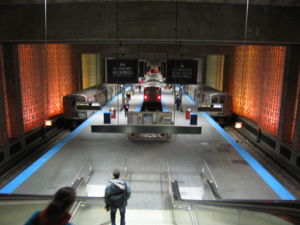
Prior to color coding, CTA rail line names were based on neighborhood or town served (Ravenswood, Englewood, Evanston, Skokie Swift), endpoint (Howard, Jackson Park, Midway, O'Hare), parallel streets (Congress, Lake), or even a city park the line traveled past (Douglas). As part of the effort to make the 'L' easier to navigate, train signs now indicate the destination terminal:[38]
- Blue Line trains display "Forest Park" signs when traveling southeast/west, "O'Hare" when traveling east/northwest. Blue Line rush-hour trains terminating in Cicero display "54/Cermak."
- Brown Line trains display "Loop" signs inbound, "Kimball" outbound. Late-night Brown Line shuttle service terminates at Belmont southbound; these trains display "Belmont."
- Green Line trains display "Harlem/Lake" when north/westbound, "Ashland/63" or "East 63rd" when east/southbound.
- Orange Line trains display "Loop" inbound, "Midway" outbound.
- Pink Line trains display "Loop" inbound, "54/Cermak" outbound.
- Purple Line local shuttles display "Howard" southbound, "Linden" northbound. Rush-hour Purple Line express trains display "Loop" inbound, "Linden" outbound.
- Red Line trains display "Howard" northbound, "95/Dan Ryan" southbound. Some southbound trains will display "Roosevelt" in the overnight hours and will cease service there vs making the complete 95/Dan Ryan run.
- Yellow Line trains display "Howard" inbound, "Skokie" outbound.
These changes do not eliminate all potential confusion, however. Visitors to the city should be aware that, since 'L' stations typically are named after the principal intersecting street, and Chicago streets tend to be long and straight, many stations on different lines have the same name. For example, there are four stations named Pulaski and five named Kedzie. It should also be noted that none of the three stations named Chicago lie in the Chicago Loop, as one might suppose; rather, the stations take their names from Chicago Avenue, which lies six city blocks (3/4 mile) north of the northern boundary of the Loop.
Chicagoland connections
The 'L' serves both Chicago airports but does not connect directly to any of the commuter rail, intercity rail, or intercity bus stations in or near the Loop, and making such connections can be unintuitive and confusing. Here's how to reach downtown Metra, Amtrak, and Greyhound terminals from the 'L':
- Chicago Union Station, terminal for all Amtrak and HC, BNSF, MD-W, MD-N, SWS, and NCS Metra trains, is 2 blocks north of Clinton (Blue Line) station and 3 blocks west of Quincy (Loop Brown, Orange, and Purple Line) station.
- Chicago Ogilvie Transportation Center (formerly North Western Station), terminal for UP-N, UP-NW, and UP-W Metra trains, is 2 blocks south of Clinton (Green Line) station and 3 blocks west of the Washington/Wells (Loop Brown, Orange and Purple Line) station.
- Chicago Millennium Station (formerly Randolph Station), terminal for Metra Electric Line and South Shore Line trains, is 2 blocks east of Randolph/Wabash (Loop Brown, Orange, Green and Purple Line) station and is accessible through the Chicago Pedway.
- Chicago LaSalle Street Station, terminal for RI Metra trains, is less than a block from both LaSalle (Blue Line) and LaSalle (Loop Brown, Orange and Purple Line) stations.
- The downtown Chicago Greyhound bus terminal is 2 blocks southwest of Clinton (Blue Line) station.
- The "L" directly serves both O'Hare Airport (Blue Line) and Midway Airport (Orange Line).
Outlying transfer points between 'L' trains and Metra:
- Main Street, Purple Line / Main Street, Metra UP-N
- Davis Street, Purple Line / Davis Street, Metra UP-N
- Irving Park, Blue Line / Irving Park, UP-NW
- Montrose, Blue Line / Mayfair, Metra MD-N
- Jefferson Park, Blue Line / Jefferson Park, UP-NW
- Kedzie, Green Line / Kedzie, UP-W
- Harlem, Green Line / Oak Park, UP-W
- Western, Blue Line (54/Cermak Branch) / Western Avenue, BNSF
- Damen, Brown Line / Ravenswood, Metra UP-N
Outlying transfer points between 'L' trains and Greyhound Lines bus service:
- Chicago 95th and Dan Ryan destination is directly above the 95th/Dan Ryan (Red Line) station.
- Cumberland destination is the Cumberland (Blue Line) station/CTA and PACE bus terminal.
- Chicago Latinos destination is closest to the California (Blue Line–Douglas Branch) station.
- Skokie destination is near the Skokie (Yellow Line) station.
Slow Zones
CTA Slow Zones By Line
- Purple: 26 percent
- Red: 24 percent
- Blue: 22 percent
- Green: 5 percent
- Yellow: 5 percent
- Brown: 1 percent
- Orange: 0 percent
- Pink: 0 percent
'L' or El?
The Chicago rapid transit system is officially nicknamed the 'L,' although this usage is not universally adhered to. In discussing various stylings of "Loop" and "L" in Destination Loop: The Story of Rapid Transit Railroading in and around Chicago (1982), author Brian J. Cudahy quotes a passage from The Neon Wilderness (1949) by Chicago author Nelson Algren: "beneath the curved steel of the El, beneath the endless ties." Cudahy then comments, "Note that in the quotation above ... it says 'El' to mean "elevated rapid transit railroad.' We trust that this usage can be ascribed to a publisher's editor in New York or some other east coast city; in Chicago the same expression is routinely rendered 'L.'" While this is broadly true, it is not hard to find exceptions. The magazine Time Out Chicago [39] refers to the system as the El[40] and once responded to a letter on the subject by explaining that it chose "El" stylistically because it would be easier for many people, especially people originally from outside of Chicago, to decipher. Be that as it may, the official, registered, trademarked name for the CTA rail system, including elevated, subway, at-grade, and open-cut segments, as used by CTA, is the capital letter "L," in quotation marks. "L" (with double quotation marks) was often used by CTA predecessors such as the Chicago Rapid Transit Company; however, the CTA uses single quotation marks (') on some printed materials and signage rather than double, and it seems safe to say there is no firm policy other than use of quotation marks of some kind. Lest one imagine a consensus has emerged among the cognoscenti on this point, however, historian Cudahy in his book routinely refers to the system as the L, without quotation marks. There does seem to be wide agreement that the rail system's name is to be capitalized; purists no doubt would insist that lower-case "el" or el is a generic term for any rapid transit line elevated above surrounding streets, such as may be found in Boston, New York, and Philadelphia in addition to Chicago. "Subway" in Chicago usage is limited to sections of the 'L' that are underground and is not applied to the system as a whole.
See also
| Wikimedia Commons has media related to: Chicago 'L' |
References and notes
- ↑ The CTA website says "CTA’s train system is called the ‘L’, short for elevated.'"
- ↑ Cudahy, Brian J., Destination Loop: The Story of Rapid Transit Railroading in and around Chicago, 1982
- ↑ MBTA rail ridership for FY04 was 625,300 if Green Line light rail ridership is aggregated with heavy rail [1].
- ↑ "Owl" service on other lines was discontinued in the 1990s for budgetary reasons. Other U.S. rapid transit systems providing 24-hour service include the New York City subway, the New York-New Jersey PATH system, and Philadelphia's PATCO Speedline.
- ↑ Chicago Transit Authority, "Rail Ridership by Branch and Entrance," July 2006, [2], accessed October 14 2006
- ↑ Chicago Transit Authority, "Rail Ridership by Branch and Entrance," December 2005, [3], accessed Sept. 1, 2006
- ↑ Chicago Transit Authority, "Rail System: Annual Traffic, 1979 to present," SDP-x93028, 7-27-93; Chicago Transit Authority, "Rail System: Annual Traffic, 1986 to 2000," PSP-x01010, 8/7/01
- ↑ Garfield, Graham, Frequently Asked Questions. Chicago-L.org (URL accessed 22 August 2006); McClendon, Dennis, "L", Encyclopedia of Chicago, accessed Aug. 22, 2006
- ↑ Leroux, Charles, "The People Have Spoken: Here Are the 7 Wonders of Chicago," Chicago Tribune, Sept. 15, 2005 [4]
- ↑ Chicago "L".org, "Chronologies - Chicago Transit Authority (CTA) (1947-present)" [5]
- ↑ Current ridership figures drawn from Chicago Transit Authority, "Rail Ridership by Branch and Entrance," June 2006 [6]
- ↑ Ridership figures reported for the Brown Line and other lines reaching downtown Chicago via the Loop elevated (Green, Orange, and Pink lines; Purple Line express trains) do not fully reflect usage since Loop boardings are reported separately. Although the figure cited above is from the CTA's June 2006 rail ridership report, the CTA elsewhere has claimed Brown Line ridership of 66,000,[7] presumably arrived at by pro rata distribution of Loop boardings.
- ↑ http://ctabrownline.com/about.html
- ↑ These and other historical details drawn from Cudahy, op.cit.
- ↑ Chicago Transit Authority, "Rail System - Nov. 1980 traffic," Table V, OP-x81085, 5-22-81
- ↑ Chicago Transit Authority, "Rail System - Weekday Entering Traffic Trends," PSP-x01013, 8-16-01
- ↑ Chicago Transit Authority, "Countdown to a New Brown - About the Brown Line" [8], accessed Sept. 5, 2006.
- ↑ Chicago Transit Authority, "Rail System - Annual Traffic: Originating passengers only," OP-x79231, 10-01-79
- ↑ http://www.northshoremag.com/cgi-bin/ns-article?article=/homegarden/06-03-movin.html
- ↑ The Roosevelt elevated stop on the Orange and Green lines, which opened in 1994, is connected to the Roosevelt Red Line subway stop by a pedestrian passage, so the CTA reports the two as a single station. Ridership in 1992 is for the subway stop only.
- ↑ Condit, Carl W., Chicago 1930-70: Building, Planning, and Urban Technology (1974), Table 7
- ↑ 1992 figures from Chicago Transit Authority, "1992 Ridership Review," Technical Report SP93-05; November 2005 figures from CTA website previously cited. Comparison may not be precise; 1992 figures were an annual average, while November 2005 reflected a single month, though one often used as a benchmark by CTA.
- ↑ Total weekday ridership at the 23 non-Loop stations now comprising the Green Line was 37,500 in 1992, 36,360 now.
- ↑ http://www.transitchicago.com/news/motion/board/slzn200608b.pdf
- ↑ http://www.transitchicago.com/news/motion/red/danryan/ transitchicago.org: Dan Ryan Red Line Rehabilitation Project
- ↑ http://ctabrownline.com/ ctabrownline.com: The Brownline Capacity Expansion Project
- ↑ http://www.chicago-l.org/plans/CircleLine.html Chicago-L.org: Circle Line Plans
- ↑ http://www.chicago-l.org/plans/2020plan.html chicago-l.org: Destination 2020
- ↑ PB Consult, Inc., Express Airport Train Service – Business Plan, Final Report, Sept. 22, 2006[9]
- ↑ Hinz, Greg, "CTA's money pit: Big bucks, small bang for agency's planned express line to O'Hare," Crain's Chicago Business,[10] Aug. 1, 2005
- ↑ Hilkevitch, Jon, "Want a 1st-class ticket to airport? CTA plan would let private company run premium – and eventually express – rail service to O'Hare and Midway," Chicago Tribune, Oct. 4, 2006
- ↑ Brown, Carole, Ask Carole, "Subway tunnel connections and airport service," Oct. 5, 2006, accessed Oct. 7, 2006. For illustration of Red-Blue line tunnel connection, see Chicago Transit Authority, Transit at a Crossroads: President's 2007 Budget Recommendations, p. 14, accessed Oct. 16, 2006[11]
- ↑ Jon Hilkevitch. Signs mark growth of CTA. Chicago Tribune, 30 October 2006.
- ↑ Kyles, Kyra, "CTA South Side shaft," Chicago Tribune (Red Eye edition), May 9, 2006
- ↑ City of Chicago, "Chicago Central Area Plan: Preparing the Central City for the 21st Century - Draft Final Report to the Chicago Plan Commission," May 2003, [12], accessed Sept. 1, 2006. For West Loop Transportation Center details, see pp. 61ff. [13]
- ↑ http://www.chicago-l.org/history/chron_CTA.html Chicago-L.org: Chronologies, accessed Sept. 5, 2006
- ↑ http://www.transitchicago.com/news/motion/pinklink/ transitchicago.com: West Side/West Suburban Corridor Service Enhancements, accessed Sept. 5, 2006
- ↑ Chicago Transit Authority, "Riding CTA Trains," [14]', accessed Sept. 1, 2006
- ↑ http://www.timeout.com/chicago/index.jsp
- ↑ For example, see this page, accessed Sept. 7, 2006.
External links
- Chicago Transit Authority - operates CTA buses and 'L' trains
- Chicago-L.org - an unofficial, extensive fan site
- CTA Tattler - Daily blog of "L" stories
- Google Map with overlay of "L" stations and routes
- Virtual L - lists restaurants, museums, and other attractions near 'L' stops
| Currently operating heavy rail rapid transit systems in the United States | |
|---|---|
| MBTA Blue, Orange, and Red Lines | MTA New York City Subway and Staten Island Railway | PATH | SEPTA Market-Frankford and Broad Street Lines | PATCO Speedline | Baltimore Metro Subway | Washington Metro | MARTA | Miami Metrorail | Tren Urbano | RTA Rapid Transit Red Line | Chicago 'L' | BART | LACMTA Red and Purple Lines |
de:Chicago Elevated es:Metro de Chicago ja:シカゴ・L pt:Metro de Chicago sv:Chicagos tunnelbana
